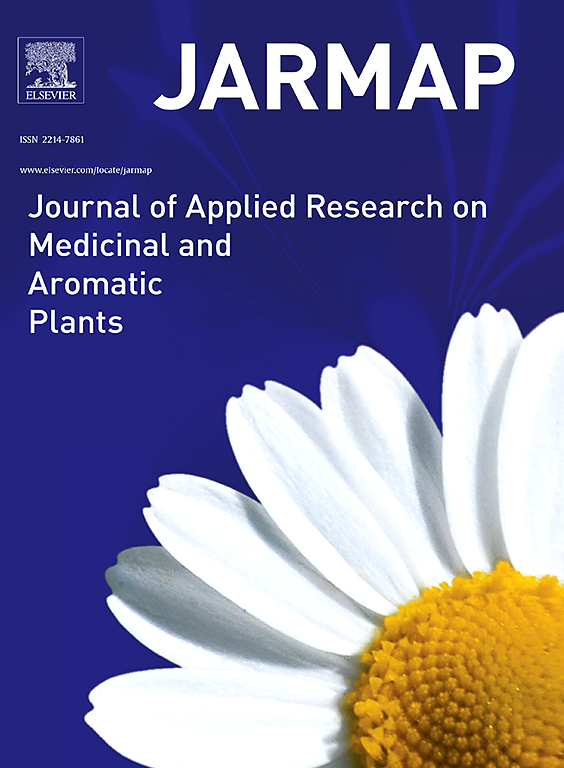Leveraging genetics to support forensic toxicology analysis: Demonstrating concordance among marijuana samples
IF 3.6
2区 农林科学
Q1 PLANT SCIENCES
Journal of Applied Research on Medicinal and Aromatic Plants
Pub Date : 2024-10-28
DOI:10.1016/j.jarmap.2024.100598
引用次数: 0
Abstract
Cannabis sativa is an important plant for industrial purposes. Indeed, it is legal to cultivate and supply authorized low level Δ9-tetrahydrocannabinol (THC) cannabis plants for fiber and seeds (i.e., 0.2 % according to the European Union regulation on drugs). Today, chromatography/mass spectrometry-based procedures are successfully applied to determine THC concentration. Unfortunately, when cannabis samples have been degraded because wrongfully stored, toxicological results were affected, altering the final status of legal sample or illegal sample. Rather, genetic identification could give more information about the identity of these plants. For this reason, a degradation study was run to support how genetics can help to detect concordance in cannabis highly-degraded samples. Forty cannabis sub-samples were stored (for one week, two weeks, one month and two months) in auto-sealing bag to assess the effects of a wrong cannabis storage on weight reduction, genomic DNA changes, and corresponding STR profiles. Once respective time-period elapsed, each sub-sample’s weight was measured, the percentage weight loss calculated, and the genomic DNA was extracted and quantified, obtaining a complete STR profile for all samples. Furthermore, the aim of this study was to assess the same 13-loci short tandem repeat (STR) multiplex system used for the degradation experiment and evaluate the power of such markers in the identification and discrimination of highly degraded cannabis samples coming from real cases. The results of this study demonstrated that the 13-loci STR multiplex system successfully achieved the objective both for industry and forensic purposes. For each sample, all 13 loci were amplified, and degraded samples were correctly identified, suggesting that genetic typification could be a useful tool. The proposed procedure could be parallelly applied to toxicology analysis to detect if vegetable sample become from authorized plant, to help courts track back illegal samples or to achieve illegal cannabis genetic profiles for further comparison.
利用遗传学支持法医毒理学分析:证明大麻样本之间的一致性
大麻是一种重要的工业用植物。事实上,种植和供应经授权的低浓度Δ9-四氢大麻酚(THC)大麻植物纤维和种子是合法的(即根据欧盟有关毒品的规定为 0.2%)。如今,基于色谱法/质谱法的程序已成功用于确定四氢大麻酚的浓度。遗憾的是,当大麻样本因错误储存而降解时,毒理学结果就会受到影响,从而改变合法样本或非法样本的最终状态。相反,基因鉴定可以提供更多有关这些植物身份的信息。为此,我们开展了一项降解研究,以支持遗传学如何帮助检测高度降解大麻样本中的一致性。将 40 个大麻子样品分别储存在自动密封袋中(一周、两周、一个月和两个月),以评估错误储存对大麻重量减少、基因组 DNA 变化和相应 STR 图谱的影响。各时间段结束后,测量每个子样品的重量,计算减重百分比,提取基因组 DNA 并进行量化,从而获得所有样品的完整 STR 图谱。此外,本研究的目的还在于评估降解实验中使用的 13 个位点短串联重复(STR)多重系统,并评估这些标记在识别和区分来自真实案例的高度降解大麻样本方面的能力。研究结果表明,13 个基因位点 STR 多路复用系统成功实现了工业和法医目的。每个样本的 13 个基因位点都得到了扩增,降解样本也得到了正确鉴定,这表明基因分型可以成为一种有用的工具。建议的程序可同时应用于毒理学分析,以检测蔬菜样本是否来自合法种植的植物,帮助法院追踪非法样本或获得非法大麻基因图谱,以便进一步比较。
本文章由计算机程序翻译,如有差异,请以英文原文为准。
求助全文
约1分钟内获得全文
求助全文
来源期刊

Journal of Applied Research on Medicinal and Aromatic Plants
Pharmacology, Toxicology and Pharmaceutics-Drug Discovery
CiteScore
6.40
自引率
7.70%
发文量
80
审稿时长
41 days
期刊介绍:
JARMAP is a peer reviewed and multidisciplinary communication platform, covering all aspects of the raw material supply chain of medicinal and aromatic plants. JARMAP aims to improve production of tailor made commodities by addressing the various requirements of manufacturers of herbal medicines, herbal teas, seasoning herbs, food and feed supplements and cosmetics. JARMAP covers research on genetic resources, breeding, wild-collection, domestication, propagation, cultivation, phytopathology and plant protection, mechanization, conservation, processing, quality assurance, analytics and economics. JARMAP publishes reviews, original research articles and short communications related to research.
 求助内容:
求助内容: 应助结果提醒方式:
应助结果提醒方式:


